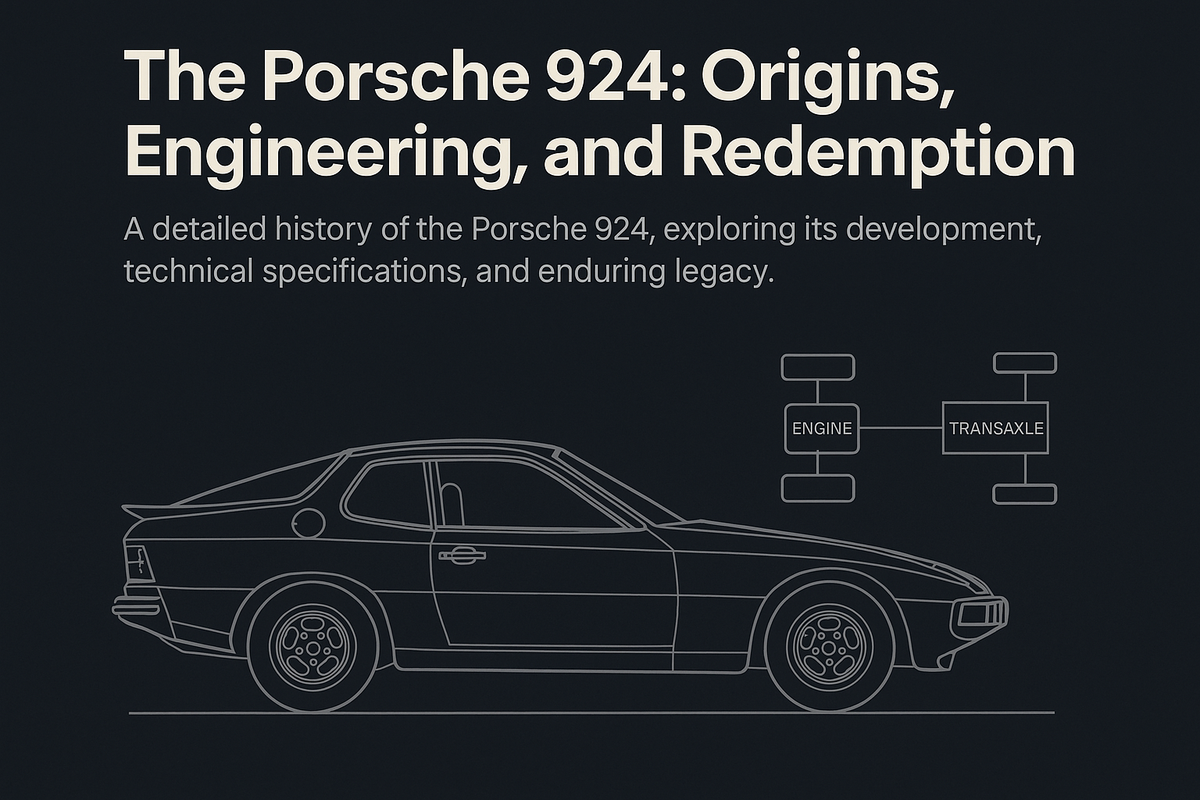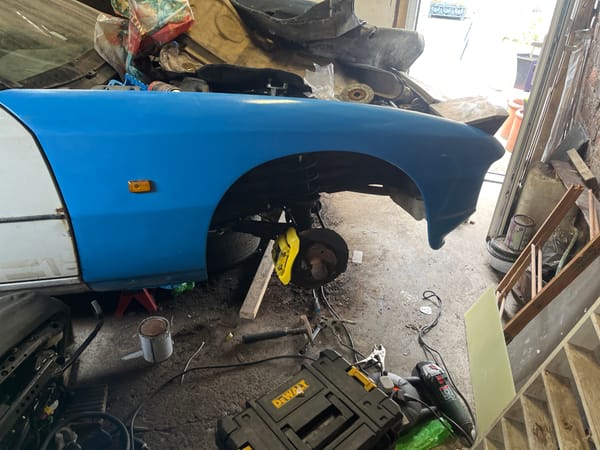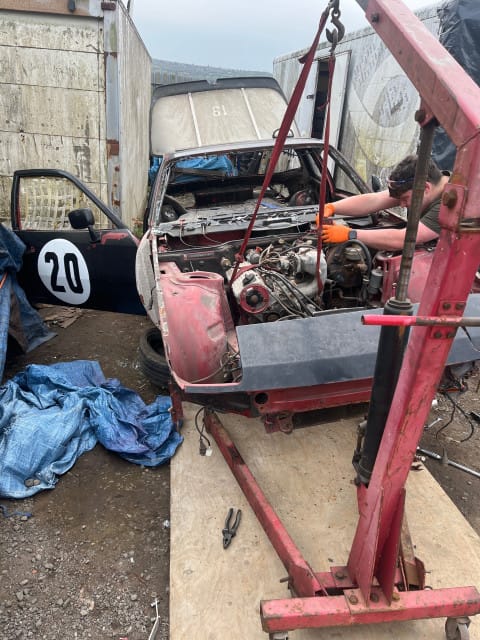The Porsche 924: Origins, Evolution, and Redemption
The Porsche 924 was never just a rebadged VW. This deep dive explores its history, variants, engineering, and why it’s finally earning respect.

Engineering Deep Dive: Under the Skin of the 924
For all the criticism aimed at the 924’s “van engine,” its underlying engineering was anything but lazy. The car’s layout, weight distribution, and modular design made it one of the most balanced platforms of its time — and a testing ground for Porsche’s transaxle future.
🔩 Engine: The 2.0L EA831 Inline-Four
The base 924 engine was a 1984cc inline-four, sourced from the Audi 100 and originally developed for the VW LT van — hence the nickname.
Block: Cast iron
Head: Aluminium, SOHC, 8-valve
Compression Ratio:
- 9.3:1 (Euro, early)
- 8.0:1 (US-spec, smogged)
Fuel Delivery: Bosch K-Jetronic mechanical fuel injection
Ignition: Bosch transistorized
K-Jetronic is a continuous fuel injection system — it meters fuel via a mechanical airflow sensor plate. Analog, simple, and hard to kill once set up correctly.
Power Output:
- 125 hp @ 5800 rpm (EU)
- 95 hp @ 5500 rpm (US, early)
- Torque: ~121 lb-ft (EU)
Common Issues:
- Warm start problems (due to pressure loss in the fuel accumulator)
- Vacuum leaks in the intake boot or auxiliary air valve
- Leaking injectors or cold-start valves flooding cylinders
🌀 924 Turbo (Type 931/932)
Released in 1978, the Turbo addressed performance criticism with a KKK K26 turbocharger and revised internals.
Key upgrades:
- Forged pistons
- Sodium-filled exhaust valves
- Oil squirters for piston cooling
- Intercooler (absent on early cars; added in Series 2 from 1980)
Boost Pressure:
- ~0.7 bar (10 psi)
Power Output:
- 170 hp (Series 1)
- 177 hp (Series 2, with intercooler)
- Torque: 181 lb-ft
Transmission:
- G31/01 5-speed dogleg gearbox (shared with early 928)
- Hardened gears, Porsche-developed
- 4-speed auto available only on base NA cars
Weak points:
- Turbo lag
- Heat-related failures: cracked manifolds, wastegate issues
- CIS metering head often struggles under boost conditions
💥 Carrera GT (Type 937)
Built for FIA Group 4 homologation, this was Porsche’s first serious front-engined race homologation special.
Specs:
- 2.0L turbo with larger intercooler
- 210 hp, 200+ lb-ft
- Close-ratio G31 dogleg gearbox
- Upgraded suspension with wider track
- Flares, ducting, fixed buckets, GT body kit
Total built: ~406 units (including pre-production and prototypes)
Carrera GTS and GTR variants (not road legal) made 245–375 hp and ran at Le Mans.
🧠 Bosch Injection Systems Compared
| Model | System | Type | Notes |
|---|---|---|---|
| 924 NA | K-Jetronic | Mechanical FI | Continuous flow, analog tuning |
| 924 Turbo | K-Jetronic | Boost-enriched FI | Complex to tune under load |
| 924S | L-Jetronic | Electronic FI | Airflow-meter based, more stable |
| 944 / 944S | Motronic | Full EFI + DI | ECU-controlled, modern feel |
⚙️ Gearboxes & Drivetrain
- NA 924 (early): Audi 4-speed (code: 016), known for long ratios
- NA 924 (later): Audi 5-speed (code: 020) — not Porsche-developed
- 924 Turbo / CGT: Porsche G31/01 5-speed dogleg
- 924S: 944-based 5-speed unit (code: 016H), much improved
- Auto Option: 3-speed VW/Audi auto — smooth but sluggish
All 924s used a rear-mounted transaxle for ideal weight distribution.
Clutch Type: Pull-type diaphragm
Driveshaft: Solid torque tube with enclosed shaft running at crank speed
Final Drive Ratios: Varied by model — most common: 3.89:1 or 4.11:1
🛞 Suspension & Handling
Front:
- MacPherson struts
- Anti-roll bar
- Coil springs
Rear:
- Semi-trailing arms
- Torsion bar setup
- Telescopic dampers
- Independent suspension
Handling is neutral to slight understeer at the limit — adjustable via tyre choice and sway bars.
Common upgrades:
- Bilstein dampers
- Polyurethane bushings
- 944 sway bars
- LEDA or KW coilovers on high-end builds
🛑 Brakes
- Early NA: Solid discs front, drums rear
- Later NA & 924S: Ventilated front discs, rear discs
- Turbo & CGT: 4-wheel discs with M471 optional brakes
Brake pedal feel is firm but progressive. Many upgrade to 944 calipers and master cylinders for improved stopping power.
ABS: Not available on any 924 variant
⚡ Electrical & Interior
- Fused circuit system, mostly reliable
- Known issues: dim lighting, ground faults, ageing switches
- Dash cracking is almost universal on early models
- Instrumentation is clean and comprehensive: tach, oil pressure, voltmeter, clock, fuel, temp
Luxury options (especially in Lux and S models):
- Power mirrors
- Electric windows
- Leather upholstery
- Pasha or pinstripe cloth seats
- Sunroof (manual or electric)
- AC (rare and often non-functioning today)
🧪 Fluids & Maintenance Intervals
| Component | Spec | Change Interval |
|---|---|---|
| Engine oil | 10W-40 semi-synthetic | 3,000–5,000 miles |
| Gear oil | 75W-90 GL-4 | 30,000 miles |
| Coolant | Phosphate-free, 50/50 mix | 2 years |
| Brake fluid | DOT 4 | Every 2 years |
| Timing belt (924S) | ContiTech or equivalent | 30,000 miles or 3 years |
📐 Dimensions & Weight
| Dimension | 924 (NA) | 924 Turbo | 924S |
|---|---|---|---|
| Length | 4,200 mm | 4,230 mm | 4,230 mm |
| Width | 1,680 mm | 1,680 mm | 1,680 mm |
| Height | 1,270 mm | 1,270 mm | 1,270 mm |
| Curb Weight | ~1,080 kg | ~1,150 kg | ~1,200 kg |
| Weight Distribution | 48/52 (F/R) | 47/53 (F/R) | 50/50 (F/R) |
🛠 Known Weak Points
- Rust: Sills, battery tray, inner wings, rear arches
- Fuel system: Accumulator and pump noise/failure
- Brakes: Rear drum cylinders leak; hard to source backing plates
- Dashboards: Cracks in all but perfect examples
- Turbo: Heat management issues — many have warped manifolds
- 924S: Timing belt tension critical to avoid interference damage
Summary
The 924’s story isn’t just a historical footnote — it’s an engineering case study. Every corner of the car reflects a philosophy: lightweight, efficient, modular. Whether you appreciate it for its balance, its mechanics, or just its role in Porsche’s evolution, the 924 is a car that rewards attention to detail.




